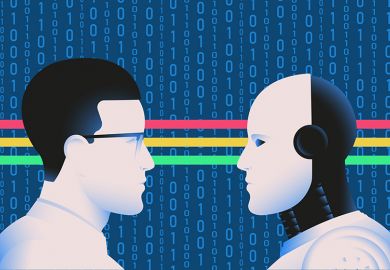Ian Tattersall is the participant-observer of palaeo-anthropology, coming to the subject via research on the lemurs of Madagascar. Detailed knowledge of this primate radiation gives him a unique perspective on our own evolution and a distinctive standing among palaeo-anthropologists in general. While other evolutionists have ventured into the subject, attempting to reform its woolly and capricious interpretations, their forays have usually betrayed a lack of familiarity with the subject's raw material. No such criticism can be levelled at Tattersall, engaged as he is in a comprehensive survey of the hominid fossil record. He has also stimulated some workers (including this reviewer) and exasperated others by a series of perceptive essays exploring the intellectual confusion surrounding the reconstruction of human evolution, the nature of hominid species and the processes underpinning hominid phylogeny.
Tattersall's qualities as an accomplished communicator are well to the fore in this short collection of essays. The book's twin aims are to summarise our understanding of human evolutionary diversity and to review the means whereby we reach that understanding. Following a brief discussion of palaeo-anthropology as science, there is a summary of evolutionary models and mechanisms, the (now not so) "modern synthesis" and its influence (a particular bugbear), punctuational and stochastic models, and the importance of local populations as engines for evolutionary diversity.
Tattersall reviews aspects of primate intelligence and consciousness, focusing on intention and deception. He rightly dismisses simplistic models that assume a one-to-one link between brain expansion and cognitive complexity. But he is also critical of modular, "Swiss Army knife" and "cathedral architecture" models of brain evolution, all of which have been influential with researchers exploring the archaeology of mind.
The chapter "Human evolution and the art of climbing trees" stresses the non-modern nature of early hominid bipedalism, reviews the earliest tools and their contexts, and describes the appearance of modern body form, exemplified by the 1.6 million-year-old Homo erectus youth from Turkana. Tattersall emphasises the disjunctive, episodic nature of hominid evolution, with long periods of stasis following the appearance of major adaptations and the diversity of the early hominid record. The picture is of species variety and radiating arrays, not progressive transformation of a single lineage.
The next chapter continues the theme with expansion beyond Africa and the occupation of Europe. Neanderthals represent one particularly well-known species among many, with earlier fossils representing an array of closely related, competing Middle Pleistocene species produced through the impacts of glacial-interglacial climatic cycles, not evidence for the gradual "Neanderthalisation" of one European species. Just as Neanderthals replaced earlier European hominids, so they in turn were replaced by modern humans about 40,000 years later. Tattersall deftly outlines the latest evidence for this episode, although his conclusions about human nature are gloomy: " Homo sapiens appears to be inherently - and probably inherently savagely - intolerant of competition from its relatives."
Despite this, the next chapter is more upbeat, summarising evidence for the emergence of modern behaviours. Tattersall argues an African source for modern humans, seeing language development as the mechanism permitting uptake of symbolically mediated behaviours underlying the Upper Palaeolithic record from about 40,000-50,000 years onwards. Earlier evolved exaptations (pre-adaptations) of the brain and throat in modern humans promoted rapid adoption of language, and so other innovations. Once adopted they gave the edge that enabled modern groups to out-compete Neanderthals and other archaics.
Tattersall provides a trenchant criticism of reductionist, genetically determinist interpretations of human behaviour, taking a particular swipe at evolutionary psychology. Modern humans are not behaviourally in thrall to their archaic genes; rather their cognitive abilities provide for unparalleled flexibility, innovation and range. But this qualitative or emergent distinction means we cannot interpret earlier hominids, even the closest forms such as Neanderthals, as junior or incomplete versions of ourselves. They were, quite simply, different.
Following initial diversification, Tattersall sees our species undergoing a phase of worldwide reintegration, precluding the establishment of newly differentiated populations. Only major - indeed apocalyptic - environmental swings involving intense selection are likely to lead to further significant evolutionary changes. Such catastrophes are possible - even probable - given humanity's dismal record of environmental destruction, but on a hopeful end-note, Tattersall believes that our remarkable brain will enable us to innovate our way out of disaster.
The book, aimed at the interested public, is vigorously and authoritatively written, and Tattersall has an enviable gift for explaining complex ideas clearly and vividly. Nonetheless, its impact would be enhanced by more than just the one illustration (an evolutionary tree with representative skulls) that, since it includes hominid species not referred to in the text, may well prove more confusing than helpful. It is disappointing also that the book is only available in relatively expensive hardback. It is to be hoped that the publisher will remedy this and produce an illustrated paperback version, for the significance of Tattersall's account and the quality of his writing deserve the widest possible readership.
Alan Bilsborough is professor of anthropology and pro vice-chancellor, University of Durham.
The Monkey in the Mirror: Essays on the Science of What Makes Us Human
Author - Ian Tattersall
ISBN - 0 19 851569 3
Publisher - Oxford University Press
Price - £17.99
Pages - 203
Register to continue
Why register?
- Registration is free and only takes a moment
- Once registered, you can read 3 articles a month
- Sign up for our newsletter
Subscribe
Or subscribe for unlimited access to:
- Unlimited access to news, views, insights & reviews
- Digital editions
- Digital access to THE’s university and college rankings analysis
Already registered or a current subscriber?



